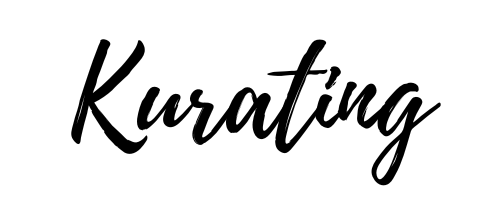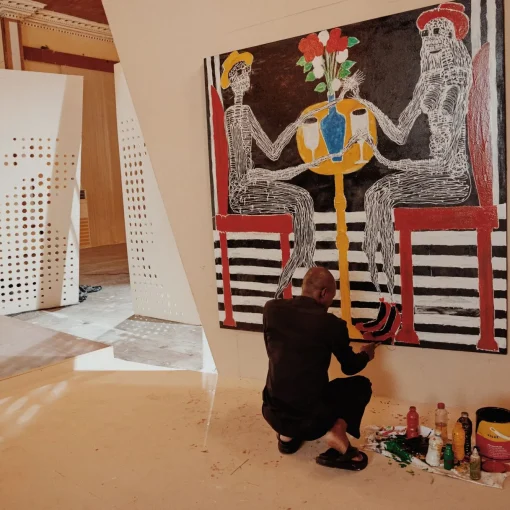
Creativity has always been embedded in Sabrina Coleman-Pinheiro’s life. As a child, she remembers trying everything, from poetry to painting and collages–even a visual diary that her mother read, to her chagrin, of course.
Growing up, it was a busy home, with cousins who came over a lot. And in that environment, she often needed to carve some mental space for herself—art was that thing for her— “it still is that for me. It’s how I express myself, it’s how I process things, it’s how I live,” she says.
She always knew she would be some kind of artist. She remembers the liberating feel of fine arts in secondary school. When it was time for university, her parents worried about her choice of degree, which they had thought was a childhood fancy that she’d outgrow. “As far as my parents were concerned, I should have been a lawyer.”
After a family meeting to deliberate her ‘rebellious choice,’ she had to settle for a compromise: A first degree in Arts and Business. Perhaps her family won because Sabrina ended up in a corporate sales career in the United States.
A return to art
Then a cousin died of brain cancer. This tragedy triggered existential questions for a depressed Sabrina. Was she really where she wanted to be in life? Reminded about how fleeting life can be, she decided she’d move back into art.
But leaving a steady career to move into arts can be a huge decision, especially when you consider income, which is often fluctuating and uncertain for artists—even for those who are quite established and fairly well known. She admits it’s a luxury to be able to make that decision and go through with it. She had some financial security; a supportive husband and some saved-up money.
For those who may not have this advantage, she advises that, rather than taking the plunge, they create a timeline and “find little creative things to feed their soul” in the meantime by “stealing pockets of time from other pursuits” to read, research, and create. She makes an example of social media and how much of a time-stealer it can be.
“The more time you spend with creative pursuits, the more reasonable the dream sounds.”
After the decision, Sabrina’s starting point was reading, researching, and asking herself what she wanted to talk about with her art. Then she started to draw and ultimately went back to painting. Part of that return-to-art process included colour studies, and investigating techniques and mediums; for example, she decided to use acrylic paint that is easier to clean and less toxic than oil paint, because she had a child.
Then, “I’ll do acrylics, but how do I extend the drying time for acrylics so I can work it like I work oil? How do I create texture because acrylics dry flat?”
There was a lot of trial and error. She believes very much in patience when creating work and her philosophy is that you can’t skip the process. “It’s important to get the bad art out,” she states. It is an idea Julian Shapiro refers to as the Creative Faucet. He says, “Visualize your creativity as a backed-up pipe of water. The first mile is packed with wastewater. This wastewater must be emptied before the clear water arrives. Because your pipe only has one faucet, there’s no shortcut to achieving clarity other than first emptying the wastewater.”
On the emotional front, there was the second-guessing of a mid-career switch; was it too late to make this move? Her reaction to this was acceptance and patience with herself. “You cannot skip the work—you have to enjoy the work.”
Exploring her mental health as a subject matter, there was also the potential of stigma and people perceiving her as ‘mad.’ In the same vein, she had to consider her conservative parents, who would prefer that such intimate topics be kept closer to home—“But everybody is mad,” she says vivaciously. “Everybody is irregular in some way.”
Influences and inspirations
While Sabrina’s work is anchored on personal struggles such as anxiety and depression, her influences are so much more; she avidly consumes literature, a poet herself, she draws parallels between poetry and painting, noting their shared ability to capture life’s complexities through vivid imagery, metaphor, and symbolism. Her literary preferences span from the works of Emily Dickinson to contemporary authors like Ngugi Wa Thiong’o, Chinua Achebe, and Chimamanda Adichie. She also finds inspiration in classic literature, from Charles Dickens to Franz Kafka’s weird stories, as well as the existentialist writings of Simone de Beauvoir and Jean-Paul Sartre.
She thinks every artist should read Art & Fear by David Bayles and Ted Orland.
Artists that inspire her include Marcel Duchamp, Lee Krasner, Cecil Brown, Mark Bradford, John Mitchel, and the women of Abstract Expressionism. She admires Claude Monet’s Impressionism and prefaces this with a note that there is the tendency for some to turn their noses up at this choice now because Monet’s work is visually pleasing. However, she highlights Monet’s historical significance and the initial criticism he faced, although his work ultimately led to the establishment of the Impressionist movement.
There’s also her love for Mark Bradford’s really big pieces; how being confronted by a big painting makes you feel small and can trigger questions about one’s importance in the grand scheme of things.
Altogether, she preaches consuming good and bad art (whatever is within reach) “When you think art is bad, there is a reason it’s bad,” so there is always some learning.
She visits galleries and shows when she can, including online galleries, but is also a fan of gallery books, with a personal collection that includes shows from Versailles, Florence, and the Chicago Institute of Art. Sabrina acknowledges that the stimulation of being present before the works in person is better, but you can’t always visit galleries, and gallery books do provide curator’s notes.
Artistic process and philosophy
All of these influences coalesce into her unique blend of the abstract and figurative to explore mental health. With each body of work, Sabrina asks herself questions about how she has dealt with her mental health challenges, pulling topics from these personal experiences shortly after wading through them. For example, in her recent piece, Seeking Solace, she asked in what ways she had found solace.
Then she moves to research to figure out the technical bits; for example, “How do I express a feeling of loneliness? Which colours will form the palette for this work?”
She sets up some parameters to ensure focus. Creating art means limitless possibilities, guardrails are often necessary to ensure you stay on course. And for her, “It’s very interesting what you can do with less.”
When she has made decisions on form and colours, she goes straight to painting to prevent overthinking. Painting is, to her, “a conversation between the artist and the piece. You put a mark down, and you figure out how you feel about the mark, and how the mark interacts with the other marks in its environment; if it’s saying what you need it to say. Usually, I don’t know what I want my painting to look like, I just know how I want it to feel when I engage with it, and my paintings are not done until I get that feeling.”
For her, the goal is not for work to be aesthetically pleasing, but for it to say something and pass across a feeling. She cites for example Marcel Duchamp’s Fountain—which was a mass-produced urinal displayed as art to engage audiences in a thought-provoking way.
Duchamp championed cerebral art, which according to him places a greater emphasis on ideas and concepts over visual appeal. He believed that art should serve the mind rather than just the eye.
Sharing and reception
However, whether art is created for aesthetic or intellectual appeal, it is often open to multiple interpretations when it’s shared with an audience. For Sabrina, this is to be expected. In her words, “You almost lose ownership once it goes into the space where it’s shown. When I have shows, I do have people ask me about the story behind it and I will tell them.”
But a lot of times, I am more curious about how they feel when they engage with the work. The art is mine until it leaves my gallery. When it leaves my gallery, it becomes a part of me that is being represented outside.”
She compares the process of creating and showing her art to being a mother bird, the creation phase being the feeding and nurturing, until she lets it fly. That moment is when she releases the work into the world and she also “becomes a spectator,” observing the reactions her works inspire.
She’s open to different reactions to her works, but not apathy–indifference can be crushing.
In the first place, showing art “can be scary,” particularly in light of how Sabrina’s pieces reflect her mental health struggles. Showing can often trigger actual panic attacks, which she intriguingly embraces. This cycle of anxiety, confusion, and self-doubt fuels inspiration for future creations as her art continues to evolve.




